Contributory members are able to log private notes and comments about each site
Sites theCAptain has logged. View this log as a table or view the most recent logs from everyone
Cap-Del Pouech Dolmen
Trip No.205 Entry No.71 Date Added: 15th Jun 2020
Site Type: Burial Chamber or Dolmen
Country: France (Midi:Ariège (09))
Visited: Yes on 10th Sep 2005. My rating: Condition 4 Ambience 4 Access 4

Cap-Del Pouech dolmen submitted by thecaptain on 13th Dec 2003. Cap-Del Pouech dolmen near Mas D'Azil, Ariege, southwest France.
I am not 100% sure whether this is the Cap del Pouech dolmen or another. I parked at the Southern entrance to the cave and followed a marked walking trail up and over the hill above the cave, following signs to the dolmen. There were other dolmens signposted in the area.
(View photo, vote or add a comment)
Log Text: Decided its silly to have come to Mas d'Azil and not gone to visit the dolmen, as it is signposted from the village, and you can drive up a narrow windy lane almost right to it, and theres a place to park just a few hundred metres from the dolmen.
It looks to me to have been re-erected at some point in the past, with one of its little supports possibly being concreted in. A large limestone capstone, 3.5 metres by 2.5 metres, sits high on top of 4 support stones, one backstone, one large and two smaller side stones. The chamber is 2.5 by 1.5 metres, and positioned on a little limestone outcrop with possibly some traces of a cairn around it.
Unfortunately, the poor thing has succumbed to the usual problems of graffitti and broken beer bottles. The dolmen de Brillaud is signposted from here, and I am tempted.....
Brillaud Dolmen
Trip No.205 Entry No.72 Date Added: 15th Jun 2020
Site Type: Burial Chamber or Dolmen
Country: France (Midi:Ariège (09))
Visited: Yes on 10th Sep 2005. My rating: Condition 3 Ambience 4 Access 3
Brillaud dolmen submitted by theCaptain on 20th Dec 2010. First view of the dolmen. arriving from the east along a well maintained and signed footpath along a lovely ridgetop.
(View photo, vote or add a comment)
Log Text: At Cap-Del Pouech, I looked carefully at my maps and found that I could drive halfway to this dolmen and hopefully park up by La Page farm, which will save on the walking. From there, it was a 25 minute walk along a well maintained and signed footpath along a lovely ridgetop, but difficult underfoot on the bare and slippery limestone and mud.
It is in fact two dolmens, both within most of their stony mounds which are adjoined. The east dolmen has a chamber 3 metres by 1.5 metres, open towards the east, with two side slabs and a capstone still in place. The back stone has broken and fallen. The western dolmen is a bit of a wreck, and only faint remains of the chamber can be seen. The overall mound is about 20 metres in length, by 10 metres wide, and seems to have some large slabs in its perimeter, defining the outside shape.
On a good day, the views from up here would be superb, the high Pyrenees to the south, and the plain of Toulouse to the north, but today its just clouds. Good job I didnt try and get to the third (Couminges) dolmen on the walk, as its already 5:30 by the time I get back to the van !
Musée de Mas-d'Azil
Trip No.205 Entry No.73 Date Added: 15th Jun 2020
Site Type: Museum
Country: France (Midi:Ariège (09))
Visited: Saw from a distance on 10th Sep 2005. My rating: Access 5
Musée de Mas-d'Azil submitted by theCaptain on 29th Nov 2010. In the village of Mas d'Azil is the natural history museum. Its in a nicely kept building just off the main village square, opposite the roofed market place right outside the church.
(View photo, vote or add a comment)
Log Text: In the village of Mas d'Azil is the natural history museum. Its in a nicely kept building just off the main village square, opposite the roofed market place right outside the church. As it was late in the day I didn’t go in. I think that if you do the caves tour, the museum visit is included for free.
Grotte de Lombrives
Trip No.205 Entry No.74 Date Added: 15th Jun 2020
Site Type: Cave or Rock Shelter
Country: France (Midi:Ariège (09))
Visited: Saw from a distance on 11th Sep 2005

Grotte de Lombrives submitted by durhamnature on 18th Nov 2012. Section of the cave at Lombrives, from "Anthropologie" via archive.org
Site in Midi:Ariège (09) France
(View photo, vote or add a comment)
Log Text: This is said to be the biggest cave in Europe, and has a complex arrangement of 25 different types of visit. Or in my case, none at all !
Parc Pyrénéen de l'Art Préhistorique
Trip No.205 Entry No.75 Date Added: 15th Jun 2020
Site Type: Museum
Country: France (Midi:Ariège (09))
Visited: Yes on 11th Sep 2005. My rating: Condition 5 Ambience 5 Access 5
Parc Pyrénéen de l'Art Préhistorique submitted by theCaptain on 16th Jul 2012. The entrance as seen from the car park.
(View photo, vote or add a comment)
Log Text: This is a wonderful day out, in a beautifully landscaped park in the wonderful Pyrenees. The visit starts in the Grand Atelier, a sort of museum of prehistoric artwhich explains all the whys and wheres of prehistoric art, not only in this region, but all over the world.
There is a special emphasis on the nearby Grotte de Niaux, and there is an excellent model of the cave to be seen. There are all sorts of audiovisual items to be seen, and the visitor is guided round with a pair of infrared headphones which pick up signals from each display. There are lots of full size recreations of parts of Niaux, including the footprints in one deep section which are not seen in the real cave visit, and copies of many of the animal paintings, including the solitary known weasel. The visit round this museum part (in my case a very interesting hour and a half) with a full size recreation of the Salon Noir from the Grotte de Niaux, with all its Buffalo and other animals. Fantastic.
Outside, in the wonderfully landscaped park, are all sorts of activities for all to take part in. There are demonstrations of archaeological techniques, footprint recognition, a musical maze, a prehistoric camp with many types of shelter recreated, with firemaking and flint knapping. Then there are hunting displays which include types of propulseur from around the world (and have a go at throwing your own spear using one - and yes, I would have gone home with dinner!), and even have a go yourself at cave painting, with demonstrations of the various techniques. This sort of museum is something I am realising that the French do very well.
All of this takes you on a lovely walk through beautiful scenery too, with grasslands, woodland, lakes and a lovely cave section - complete with footprints, fossils, idols and waterfalls. I just loved it here. I thought that I would quickly rush round the place, but spent nearly all day here. It even has a decent restaurant and a good shop, which unfortunately means buying more books! Thoroughly recommended as a top day out for all.
Grotte de La Vache
Trip No.205 Entry No.76 Date Added: 15th Jun 2020
Site Type: Cave or Rock Shelter
Country: France (Midi:Ariège (09))
Visited: Yes on 11th Sep 2005. My rating: Access 4
Grotte de La Vache submitted by TheCaptain on 24th Nov 2010. Part of the Grotte de La Vache, opposite side of the valley to the Grotte de Niaux, in Ariège.
(View photo, vote or add a comment)
Log Text: Just opposite to the Grotte de Niaux, on the other side of the valley, is the Grotte de la Vache, with its celebrated Salle de Monique. The cave is open for visits at €8 a time, but because I had spent so long at the nearby Parc Pyrénéen de l'Art Préhistorique, the visits had finished for the day when I arrived.
The information at the cave states that it is the smallest cave open for visits in the Pyrenees, but has had the most finds and articles taken from it. Amongst these are many engraved bones and antlers, including the famous lions. Within the cave is a description of life during the Magdaleinean, 13,000 years ago, with workshops etc held around the fireplace.
To get here, park in the village of Alliat, and then its about a 500 metre easy walk around the hillside. The cave is signposted from all around.
Grotte de Niaux
Trip No.205 Entry No.77 Date Added: 15th Jun 2020
Site Type: Cave or Rock Shelter
Country: France (Midi:Ariège (09))
Visited: Saw from a distance on 11th Sep 2005. My rating: Access 4

Grotte de Niaux submitted by thecaptain on 14th Aug 2008. Bison inside the Grotte de Niaux.
(View photo, vote or add a comment)
Log Text: The world famous cave, known for its tremendous paintings of bison and horses, is easily found just up a small valley to the west of Tarascon, and is signposted from all around, you can hardly miss it. The cave is up the hillside from the village of Niaux with its museum, and is situated opposite to the Grotte de la Vache.
The modern day entrance, with its rusting iron "artwork" is high up the hillside in an enormous opening, which was not the original entrance to the cave in ancient times, which was further down in the valley. Visits are year round, but only a few people are allowed in on any day to help preserve the conditions inside, so it is usually necessary to book your visit in advance.
Source de Fontestorbes
Trip No.205 Entry No.78 Date Added: 15th Jun 2020
Site Type: Holy Well or Sacred Spring
Country: France (Midi:Ariège (09))
Visited: Yes on 11th Sep 2005. My rating: Condition 4 Ambience 4 Access 5
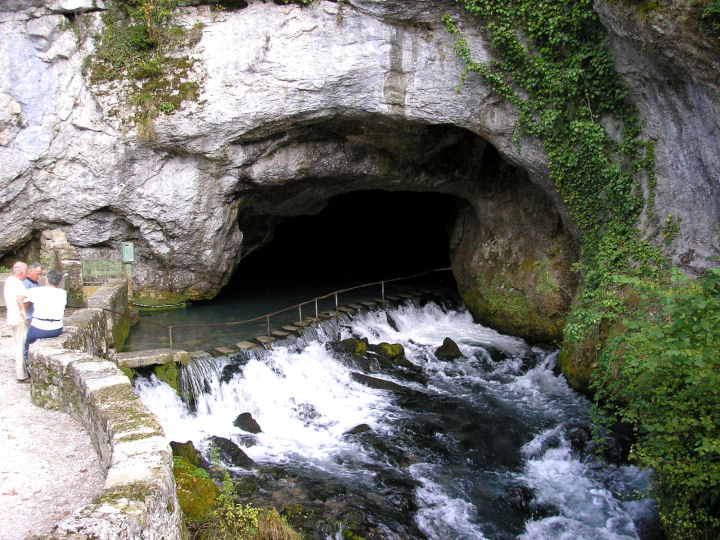
Source de Fontestorbes submitted by thecaptain on 28th Feb 2006. The intermittent Source de Fontestorbes in full flow.
(View photo, vote or add a comment)
Log Text: This is a very interesting place, one of only a few known examples in the world, with its intermittant spring gushing from a cave in a cliff face beside the road, well signposted a kilometre or so to the south of the little Pyrenean town of Belesta. In the dry summer months, due to a complex and not fully understood syphoning mechanism, the spring alternates between full flowing river, and barely a trickle, on an approximately hourly cycle for about 4 months of the year.
The place has been well done up since I was last here 5 years ago, with new parking area, a pedestrian bridge built over the stream, and a building with shop and cafe facilities, with more planned such as a picnic site and nature walk, and there were quite a lot of people here.
When I arrived, the spring was gushing quite a lot, the water easily covering the little steps across the entrance into the cave, just as it was every other time I have visited here in the past (I think I have been here about 4 times before, and never seen the spring dry up). So I went for a look round the little info centre, which now has a bar and lots of information about various tourist places and things, and was being run by a nice friendly couple, and it even has information leaflets about the spring in English these days. This explains the best understanding of the springs working, and states that it does not start cycling until after a long dry spell in the summer (I had always been in spring or early summer before).
As I left the centre, and had another look at the spring, it seemed to be slowing down. After another 5 minutes, the flow had lowered enough that a chap could walk across the steps and into the cave. Ten minutes later, it had slowed right down to a trickle, allowing people to walk across the stepping stones into the cave. It was not easy to see where the water comes from, it must be somewhere under the floor of the pond.
As would be expected of such a strange place, it has been revered since time immemorial, and of course there are many legends and stories associated with it. Excellent, I have at last seen this thing at work !
Grand Menhir de Counozouls
Trip No.205 Entry No.84 Date Added: 28th Oct 2020
Site Type: Standing Stone (Menhir)
Country: France (Languedoc:Aude (11))
Visited: Yes on 12th Sep 2005. My rating: Condition 4 Ambience 4 Access 4
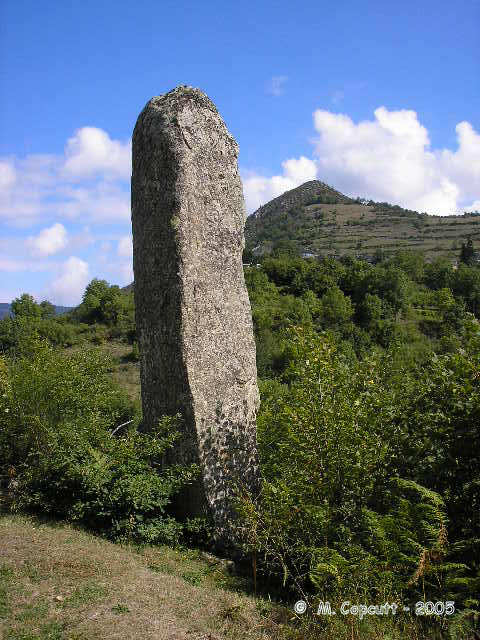
Grand Menhir de Counozouls submitted by thecaptain on 15th Nov 2005. Le Grand Menhir de Counozouls, the largest in southern France, stands at 8.9 metres tall.
(View photo, vote or add a comment)
Log Text: After a seemingly very long drive south from Quillan, along roads hacked into cliff faces, passing through numerous massive gorges which at times I never thought the campervan would fit through, I arrived at the village of Ste Colombe-sur-Guette. A few more miles south along the road in the valley, then climbing steeply up the side of the gorge, all the time bearing in mind theres a 3 metre height limit signposted, but which thankfully turns out to be only at one side of the road. Turn left and cross the bridge towards Cournozouls, and go a further 1.7 kilometres, until you come to a double right hand bend.
There is room to park here on the outside of the curve, and just here can be found this massive menhir, standing below the road on the steep hillside, with a little path leading down to it, and thankfully the trees around it now cleared. The stone now stands proudly in the open, with a lovely view of the village across the valley. The stone stands over 8 metres in height, making it the biggest in southern France, and one of the tallest in the entire country. It is a large granite lump, and initially looks a bit like it might be a natural lump fallen down the mountain. However it certainly looks to have been shaped, and wedged into its upright position, and I am assured it is a proper menhir.
Tautavel Musee de Prehistoire
Trip No.205 Entry No.85 Date Added: 28th Oct 2020
Site Type: Museum
Country: France (Languedoc:Pyrénées-Orientales 66)
Visited: Yes on 12th Sep 2005. My rating: Condition 4 Ambience 3 Access 4
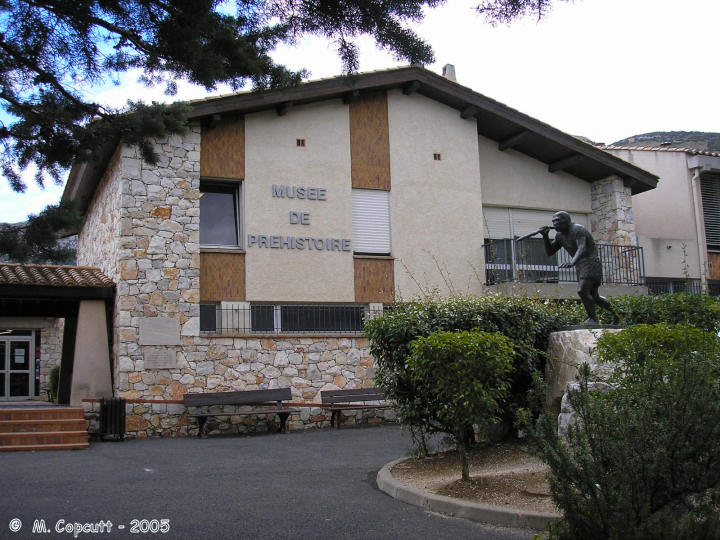
Tautavel Musee de Prehistoire submitted by thecaptain on 16th Dec 2005. Museum in the village of Tautavel in the French departement of Pyrénées-Orientales, which is the home to one of the oldest known European Humans.
(View photo, vote or add a comment)
Log Text: I only came here to get a photo, assuming the museum would be closed on a Monday, but it was open, so thought I'd better go in. The museum contains hundreds of thousands of items found at the nearby Caune de l'Arago cave, where the remains of a human skull was found in July 1971, the skull being known as Arago item 21. Since then many others have been found, along with items of their food, tools etc etc. The finds have been dated to about 450,000 BC, and thus are amongst the earliest remains of humans found in Europe.
Tautavel man lead a life of hunting, and this is all displayed here also, with remains of many animals and suchlike which would have been around at that time. Tautavel man, however, is not an ancester of ours, as he lead up to Neanderthal man, which died out 30,000 years ago, to be replaced by Cro Magnon man.
While this should all have been very interesting, I have to admit to finding many of the displays quite dull and repetitive, and the awful American voice talking down to me in the audio guide was enough to put me right off. The whole museum seemed a bit 1970's and showing signs of age. The displays mostly consisted of bones and tools in glass cases, video presentations of certain things, and staged scenes using mannequins, with lots of keep off and don't touch signs. In my recent travels, I have seen many much better presented museums which bring the subject to life.
La Caune de l'Arago
Trip No.205 Entry No.86 Date Added: 28th Oct 2020
Site Type: Cave or Rock Shelter
Country: France (Languedoc:Pyrénées-Orientales 66)
Visited: Saw from a distance on 12th Sep 2005
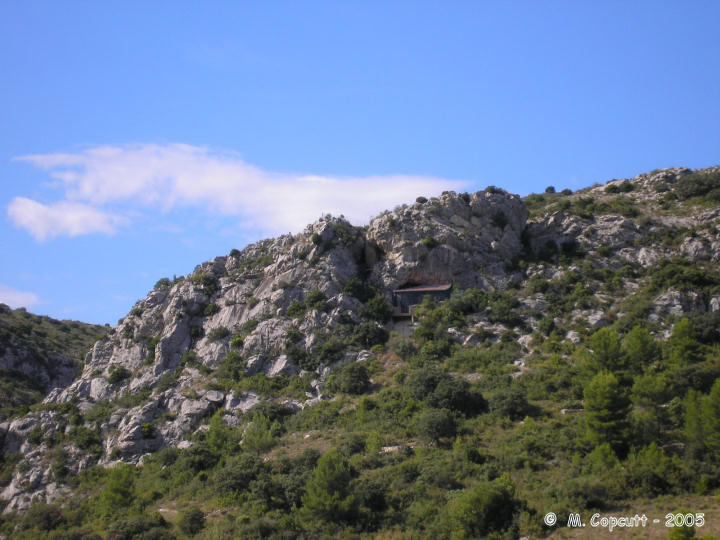
La Caune de l'Arago submitted by thecaptain on 16th Dec 2005. In a very pretty part of the world up on a cliff face above the vinyards, this is the cave where the skull of Tautavel man, one of the oldest known Europeans, was found.
This is of course all shut off to the public with buildings and shelters around it, as the excavations and research continue, 35 years after the finding of the ancient skull.
(View photo, vote or add a comment)
Log Text: In a very pretty part of the world up on a cliff face above the vinyards, this is the cave where Tautavel man was found. Its a kilometer or so south of the town, up on a rugged hill near where the river cuts a gorge through the hills. This is of course all shut off to the public with buildings and shelters around it, as the excavations and research continue, 35 years after the finding of the ancient skull.
Puijols tumulus
Trip No.205 Entry No.87 Date Added: 28th Oct 2020
Site Type: Artificial Mound
Country: France (Languedoc:Pyrénées-Orientales 66)
Visited: Saw from a distance on 12th Sep 2005
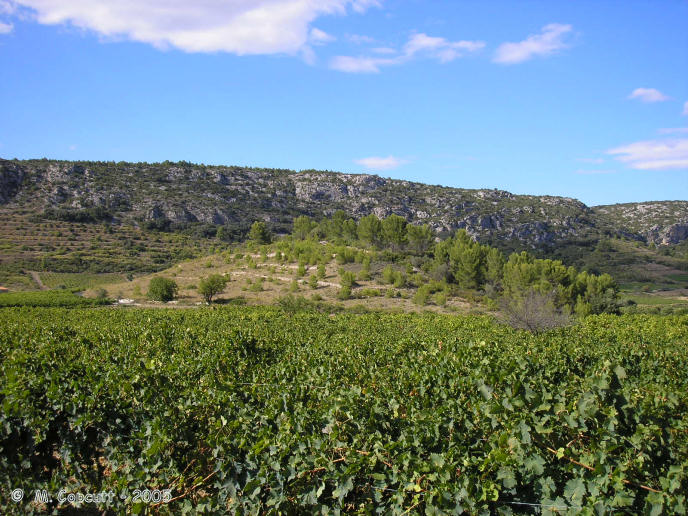
Puijols tumulus submitted by thecaptain on 4th Mar 2006. To the northwest of the village of Tautavel is a massive mound, which must be about 100 metres in diameter and 20 metres high, complete with terracing where grapes have been grown on it !
A local map clearly marks it as a tumulus.
(View photo, vote or add a comment)
Log Text: Just to the northwest of the village of Tautavel, on the opposite side of the river, is a massive tumulus, which must be about 100 metres in diameter and 20 metres high, complete with terracing and grapes growing on it !
Bélesta Museum of prehistory
Trip No.205 Entry No.88 Date Added: 28th Oct 2020
Site Type: Museum
Country: France (Languedoc:Pyrénées-Orientales 66)
Visited: Saw from a distance on 12th Sep 2005

Bélesta Museum of prehistory submitted by thecaptain on 3rd Mar 2006. Supposedly excellent museum located in the chateau in centre of the village of Bélesta in Pyrénées-Orientales.
(View photo, vote or add a comment)
Log Text: Blimey, the roads round here are twisty and tight. There was no way I was able to park the van anywhere near the village for a look at this. So I had to give up totally on any thoughts of a visit to this supposedly excellent museum.
Moli del Vent
Trip No.205 Entry No.89 Date Added: 28th Oct 2020
Site Type: Burial Chamber or Dolmen
Country: France (Languedoc:Pyrénées-Orientales 66)
Visited: Yes on 12th Sep 2005. My rating: Condition 5 Ambience 5 Access 4

Moli del Vent submitted by thecaptain on 3rd Mar 2006. The little chamber is approached from the south by a corridor from the edge of the cairn, made with a few upright slabs and drystone walling.
The chamber is topped by a gorgeously shaped capstone
(View photo, vote or add a comment)
Log Text: At the top of the hill to the north west of the village of Bélesta can be found the superb but restored remains of this lovely little dolmen-a-couloir. The little chamber is about 2 metres by 1 metre, and the south side is approached by a corridor 5 metres long from the edge of the cairn, made with a few upright slabs and drystone walling. The chamber has an upright slab at each side, and two back slabs, topped by a gorgeously shaped capstone about 3m by 2m. The whole thing is contained within a round cairn, about 9 metres in diameter and 0.5 metres high.
The views from up here are superb, the Fenouillades valley to the north, and the Canigou brooding in amongst the clouds to the south west today. The dolmen is less than a kilometre walk up a good track from a junction of minor roads with plenty of space for parking, and is well worth the effort. It is possible that there are remains of other monuments round the area.
Peyro Dreta
Trip No.205 Entry No.90 Date Added: 28th Oct 2020
Site Type: Standing Stone (Menhir)
Country: France (Languedoc:Pyrénées-Orientales 66)
Visited: Yes on 12th Sep 2005. My rating: Condition 2 Ambience 3 Access 4

Peyro Dreta submitted by thecaptain on 3rd Mar 2006. This fallen and broken menhir, once more than 4 metres tall, has beautiful views over the Fenouillades valley to the north, with Queribus castle and Tautavel clearly visible.
(View photo, vote or add a comment)
Log Text: This fallen and broken menhir, once more than 4 metres tall, has beautiful views over the Fenouillades valley to the north, with Queribus castle and Tautavel clearly visible. The menhir can be found about a kilometres walk down a dirt track amongst the vines, about 0.7 kilometres to the west of the Col de Bataille. The start of the track is easy to find, as it is marked with a large menhir like stone at the junction beside the vineyards. Perhaps this stone itself was once a proper menhir, which has now been re-erected.
Dolmen de la Creu de Falibe
Trip No.205 Entry No.91 Date Added: 5th Nov 2020
Site Type: Burial Chamber or Dolmen
Country: France (Languedoc:Pyrénées-Orientales 66)
Visited: Yes on 13th Sep 2005. My rating: Condition 5 Ambience 4 Access 4
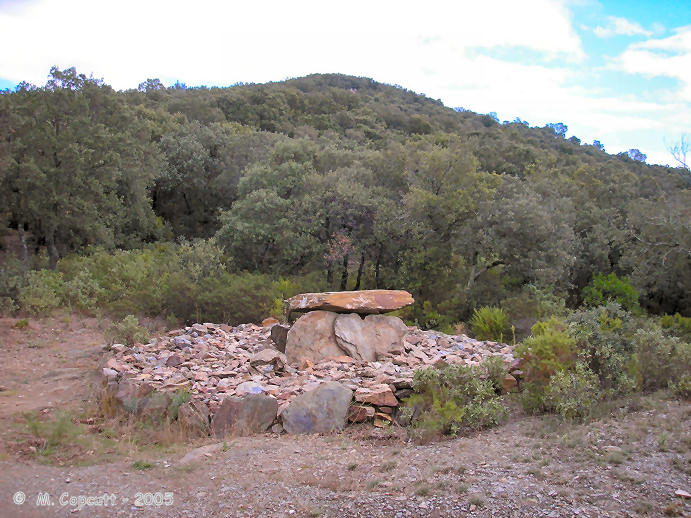
Dolmen de la Creu de Falibe submitted by thecaptain on 17th Mar 2006. This lovely restored dolmen in a round cairn with a heavily carved capstone can be found in the mountains to the south of the village of Saint-Michel-de-Llotes in Pyrénées-Orientales.
(View photo, vote or add a comment)
Log Text: This lovely restored dolmen can be found in the hills to the south of the village of Saint-Michel-de-Llotes. Travelling south, turn left at the village beside the Catalane museum, over the bridge. Follow this road for several kilometres, twisting and turning up into the mountains, to the Col de la Croix de la Falibe. Its further than you would think, and you even start going downhill again before you get there, but once there its obvious, and has a sign to the dolmen along the large track to the left, with plenty of room to park. If you're feeling adventurous, it would be possible to drive along this stoney track, as I was walking along it a car did in fact pass me.
Go about a kilometre along the track, and at the top of the ridge you will fond the dolmen, contained within its circular cairn. The chamber is rectangular, 2.5 m by 1.5 , surrounded on all four sides by upright slabs. The capstone is supported on the two long sides by the side slabs, while at the ends the slabs do not reach the top. The chamber is paved, and has a single capstone on top, which is only 2.5 metres by 1.5 metres, just big enough to cover the chamber. The capstone is heavily carved, and has many cupules, lines and crosses engraved into the top. The crosses are made by joining between 4 small cupules. Some of the cupules are quite large, up to 10 cm in diameter, and these larger cupules are linked together with larger engraved lines, making a sort of fish shape around the capstone. The whole top of the capstone is carved, and is most intriguing. The dolmen itself is contained within the remains of a stone cairn, about 10 metres in diameter, and with large stone edging all the way round.
This is a lovely place to visit, well worth the time, and the views nearby, although not from the dolmen itself, are splendid.
Dolmen de Serrat d'en Jacques
Trip No.205 Entry No.92 Date Added: 5th Nov 2020
Site Type: Burial Chamber or Dolmen
Country: France (Languedoc:Pyrénées-Orientales 66)
Visited: Yes on 13th Sep 2005. My rating: Condition 4 Ambience 5 Access 3
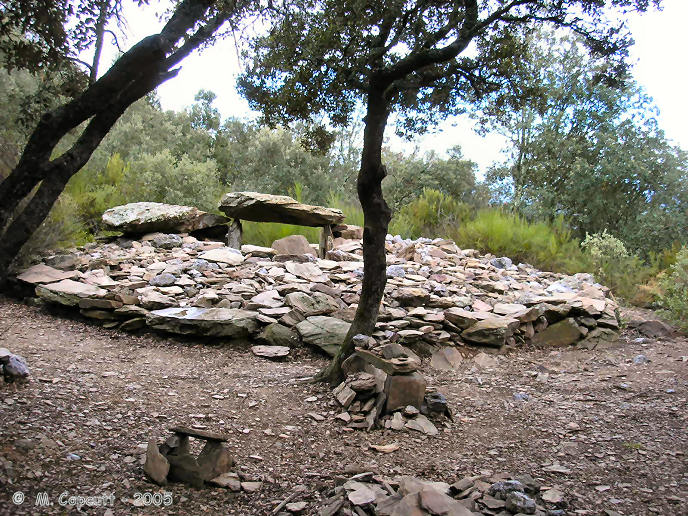
Dolmen de Serrat d'en Jacques submitted by thecaptain on 8th Mar 2006. A couple of hundred metres from the Creu de la Llosa dolmen, following the footpath uphill through the scrub to the east, and you can find another dolmen, similar in size, but this time with an entry passage through its cairn.
(View photo, vote or add a comment)
Log Text: A couple of hundred metres from the Creu de la Llosa dolmen, following the footpath uphill through the scrub to the east, up towards Serrat d'en Jacques, and you can find another dolmen, similar in size to the Creu de la Llosa dolmen, but this time with an entry passage through its cairn. I do not know the name of this dolmen, and I assume it has also been fairly recently restored.
The cairn is about 10 metres in diameter and surrounded by large slabs, with a height of about 0.5 metres. The dolmen, approximately central, has a chamber 3 metres long, and varying in width from about 1.8 m at the front to 1 m at the back. Again, the floor is paved, and there is a part height stone across the front. There are three side slabs each side, and a full height backstone. There were either several capstones, only one of which is now in position, or else a single large one has been broken. On top of the remains of the capstone are one or two cupules, but nothing much else in the way of engravings. To the southeast is an entrance chamber, facing 118°, paved and about 2.5 metres in length to the edge of the mound, making up to the full width of the chamber.
The views from this dolmen really are superb, but unfortunately slightly obscured by the highly scented scrubland. The Canigou is clearly visible to the southwest, but still enveloped in its clouds today. Excellent.
Dolmen d'A Fourna
Trip No.205 Entry No.93 Date Added: 5th Nov 2020
Site Type: Burial Chamber or Dolmen
Country: France (Languedoc:Pyrénées-Orientales 66)
Visited: Yes on 13th Sep 2005. My rating: Condition 4 Ambience 5 Access 3

Dolmen d'A Fourna submitted by thecaptain on 9th Mar 2006. About four hundred metres from the Creu de la Llosa dolmen, following the little footpath through the scrub to the southwest, is another dolmen.
This dolmen is in a round cairn about 8 metres in diameter, and has an entrance passageway, wider than the chamber, 4 metres long.
(View photo, vote or add a comment)
Log Text: About four hundred metres from the Creu de la Llosa dolmen, following the footpath through the scrub to the southwest (note, go back down the track for about 25 metres from the dolmen to find the path - it is not the "obvious" path leading away from the dolmen), around the southern side of the ridge, and you will find another dolmen of similar type.
This dolmen, which again I assume restored, is slightly smaller, in a round cairn about 8 metres in diameter. The dolmen chamber is about 2 metres long by 1 metre wide, and covered with two small capstones, sitting on blocky side supports, only to about 1.2 metres in height. It has an entrance passageway, wider than the chamber, which is 4 metres long and opens up on an alignment of 120°, directly pointing towards a large and significant mountain peak. The capstones are both engraved, the front, larger one having multiple cupules with the faintest of some lines and cupules, while the smaller backstone has an extremely clear cross, with maybe some other, more fainter markings.
What a lovely place it is up here, pity the sky is cloudy and the views unclear. It also makes me wonder just how many more of these dolmens there are to be discovered in the forests up on these mountains.
Dolmen de la Rouyre
Trip No.205 Entry No.94 Date Added: 5th Nov 2020
Site Type: Burial Chamber or Dolmen
Country: France (Languedoc:Pyrénées-Orientales 66)
Visited: Yes on 13th Sep 2005. My rating: Condition 3 Ambience 4 Access 3
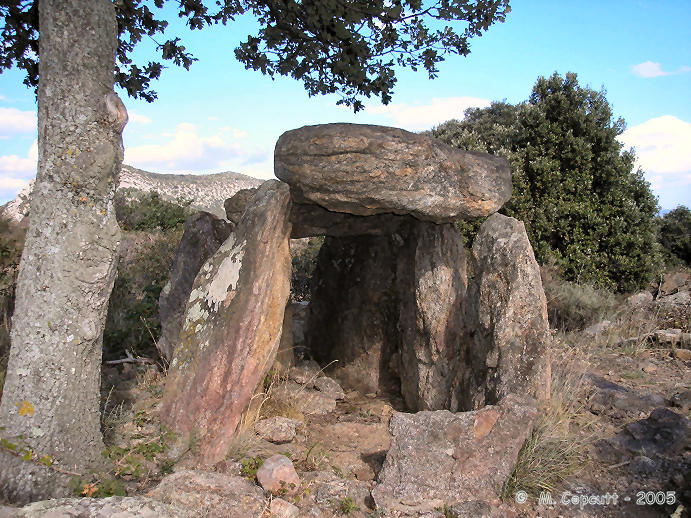
Dolmen de la Rouyre submitted by thecaptain on 10th Mar 2006. High up on this mountain ridge between the villages of Fesluns and Ansignan in Pyrénées-Orientales can be found the remains of this cute little dolmen.
Its a tiny little thing, just 2 metres in length by 1 metre wide, and a metre high.
(View photo, vote or add a comment)
Log Text: High up on this mountain ridge between the villages of Fesluns and Ansignan in Pyrénées-Orientales can be found the remains of this cute little dolmen. I followed signs from Ansignan, but walked because I was not going to get the camper van up the steep, tiny, windy little roads, but a small car would get fairly close. I had no idea how far it was going to be to the dolmen, and perhaps wouldn't have started out had I known in advance. It turned out to be almost an hour brisk uphill walk before I made it to the dolmen.
It's a tiny little thing, just 2 metres in length by 1 metre wide, and a metre high. Two small capstones rest on 3 and 2 side supports, with a back stone and a half height stone at the front. There is evidence of a stone cairn, with encircling larger stones, about 8 metres in diameter. The chamber opens to the southwest at 240°, but perhaps this is the back. Maybe some of the chamber has disappeared, and it is possible that there was an entry corridor towards the southeast, but it is very hard to tell.
Was it worth the couple of hours of steep uphill walk for the visit? yes and no. The views were lovely once up here, and there were some beautiful butterflies to be seen in amongst the vines near the top of the ridge. Apart from driving to a closer position in a small car, it is possible that you could approach this dolmen from the west, which may also make it much easier to find.
Aqueduc d’Ansignan
Trip No.205 Entry No.95 Date Added: 7th Nov 2020
Site Type: Ancient Mine, Quarry or other Industry
Country: France (Languedoc:Pyrénées-Orientales 66)
Visited: Yes on 13th Sep 2005. My rating: Condition 4 Ambience 4 Access 4
Aqueduc d’Ansignan submitted by TheCaptain on 6th Nov 2020. Ancient bridge and aqueduct spanning the river below the village of Ansignan, the basis of which is a Roman bridge, probably from the 3rd century.
(View photo, vote or add a comment)
Log Text: Ancient bridge and aqueduct spanning the river at the village of Ansignan, still used to irrigate crops on the opposite bank. It is built on the basis of a Roman bridge, probably from the 3rd century.
To cross the bridge, with the aqueduct built on top, you walk within an enclosed passage with a few holes for light, and it seems rather like walking along a passage within the walls of a castle.
